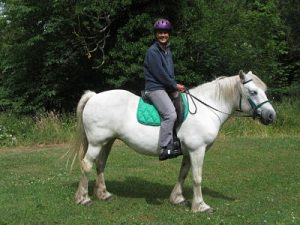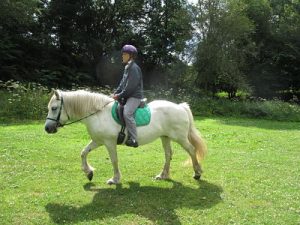 My first experience of sitting on a horse was when I was in my twenties and it ended with me gradually sliding off sideways on to the ground when the horse suddenly broke into a trot. My second experience was a few years’ later and was slightly different – this horse decided to throw me over its head into the mud once it realised that I didn’t have a clue what I was doing.
My first experience of sitting on a horse was when I was in my twenties and it ended with me gradually sliding off sideways on to the ground when the horse suddenly broke into a trot. My second experience was a few years’ later and was slightly different – this horse decided to throw me over its head into the mud once it realised that I didn’t have a clue what I was doing.
Fast forward a decade to near the beginning of my training to be an Alexander Technique teacher. As part of the course we were to visit the local riding school once a year. There we found gentle, sedate horses but, despite their slow pace, my previous experiences had left me somewhat apprehensive – not least because now we were to have no stirrups, nor reins to hold on to. I survived but it wasn’t a particularly enjoyable experience, particularly when we were asked to keep our eyes closed and arms raised out to the sides, even while the horse was turning around in the yard. However, when we returned a year later I realised how much progress I must have made in my Alexander training, as this time I found myself feeling much more confident and at ease. Clearly my balance had improved through the training and I was more able to just go with the experience, using my Alexander thinking skills to prevent me slipping into my old habits of panicking and tensing up.
A couple of weeks ago I was fortunate to be able to spend a morning with Alexander teacher and rider, Chrissy Pritchard at her beautiful place in Lanarkshire. Chrissy had offered her colleagues the opportunity of having a go at riding her highland pony. For me this would be the fifth time in my life when I had tried riding but my colleagues’ previous experience ranged from none at all to having ridden as a teenager. What impressed me was that, regardless of previous experience, we were all able to ride quite well after just a few words of instruction from Chrissy. This lovely morning reminded me that learning the Alexander Technique actually teaches us how to learn.
So how does the Alexander Technique help us learn? When learning a new skill the tendency is to fixate on the thing that we want to achieve, the goal, leaving little thinking space for what’s the best way of getting there. What the Alexander Technique enables us to do is to pay attention to the bigger picture, so that we can create the best conditions possible for achieving that goal (being in balance and poised, moving in a well-coordinated way etc). Here’s a glimpse of what the process was for me:
As always, there were my previous experiences in the back of my mind – not just of being on a horse but all those times I’ve been confronted with something new and ‘tried to get it right’. By acknowledging these thoughts but choosing not to react to them by ‘getting prepared’ (which usually involves tensing up and over-focusing on the outcome) I was able to stay more in the present rather than dwelling in the future or in the past. As I got onto the pony I took a moment to be aware of myself, the pony and our surroundings and then thought of the crown of my head leading the way upwards (rather than pressing down heavily on my foot in the stirrup). Then I was finding my balance on my sitting bones and continually coming back to an awareness of my sitting bones and the rest of me, as well as what was around me. Holding the reins as Chrissy showed me I aimed to notice if I started to grip at any point. Similarly, I paid attention to any tendency to grip the pony with my legs, wishing instead to let my legs hang suspended freely, with my weight dropping straight down through my sitting bones, while maintaining a good contact with the pony. At one point Chrissy suggested that I subtly shift my weight on the saddle and as I did this I noticed I came into a better balance and that the pony responded positively to this. Then setting off with a gentle nudge with my legs and a ‘walk on’.
One of the things that we get better at through the Alexander Technique is being clearer in our intention and less distracted by other stimuli. So, getting the pony to go in the direction we want is helped by looking ahead in the direction of travel and allowing our intention to come through ourselves to the pony – if I’m thinking of turning right, and as long I don’t allow my habits to interfere by tensing up, then my weight will tend to subtly shift with my intention, more onto my right sitting bone and the pony will get the message. So, applying the Alexander Technique involves self-awareness and making conscious choices over how we’d like to respond (think/move/act). Seeing to what extent we’re able to stick to those choices rather than just reverting back into habit is all part of the learning process and an interest in that process helps us not to over-focus on the particular goal in question.

Through our Alexander experience we just needed a few simple instructions from Chrissy, and we were all able to learn the basics of horse riding in just a few minutes. Obviously if we wanted to become expert horse riders, like anyone, we would need to practice the specific skills involved but we would have the benefit of the Technique to help us get to whatever level of riding expertise we wanted.
Thankfully, the Alexander Technique is being taught more and more in schools and colleges but people of all ages want to learn new skills during their lives – the Alexander Technique gives us the best approach to learning, and can be applied to anything.